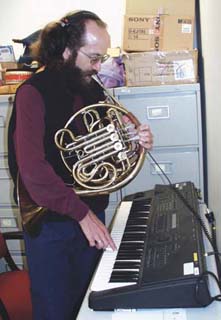.gif)
|
However, the same sounds from a real musical instrument will be slightly different, he said. “There will be slight differences to the sound, slight changes in the amplitude, and lots of little nuances. The little differences are what tell listeners it’s a real performer instead of a synthesiser.” To correct the deficiency, Prof Horner and his researchers at HKUST’s computer science department looked at altering synthesised sounds through a spectrum equaliser. The main concerns were how much the sound needed to be altered before any change could be detected, and at what point the sound had been changed so much it could not be easily associated with the instrument making it. Eight “sustained” musical instruments were chosen for a human listening experiment, or discrimination test: the trumpet, bassoon, clarinet and flute, the French horn, oboe, saxophone and violin. “Sustained means you can make the sound last for as long as you keep putting energy into it,” said Prof Horner. He then selected a panel of 20 listeners, half with no musical experience and the remainder with at least five years musical experience. Using a spectrum equaliser, the sounds of the musical instruments were changed by 50 varying degrees and played to the panel. Results showed that for all instruments no changes could be detected when sounds were modified by up to 8 percent, but the instruments became difficult to recognise when the sounds were modified by more than 32 percent. “The key was in knowing how much was too much and how much was too little,” said Prof Horner. At alteration levels of about 20 percent, “an interesting collection of similar yet different sounds was produced,” he added. One of the applications of the research is to have keyboard synthesisers make the same sound variations, introducing the natural nuances. Said Prof Horner: “There’s a very cheap and easy way to do it, in fact. You can easily implement it on all existing keyboards with only minor changes in the synthesiser design.” The natural sounds could be introduced by adding a simple filter, he said, either as part of the hardware or in the software. A filter can change the quality of the sound, in this case in a relatively small way. Its frequency response would be set with a different random value for every note, said Prof Horner. Interest in the research, which is scheduled for completion in August, has so far come from audio designers. Another application of the research, also for audio designers, is to define the limit they can cut corners in designing loudspeakers or other audio components. “It’s the point of no return for audio designers when a sound is not like it is supposed to be any more, especially in loudspeakers. You don’t want to have your loudspeakers altering the sound so much that the user cannot recognise what the music was originally; that’s the limit for even the cheapest loudspeakers,” said Prof Horner. Principal Investigator |
||||||||||||||||||||||||
